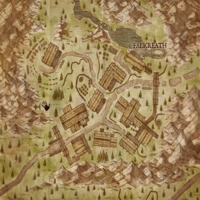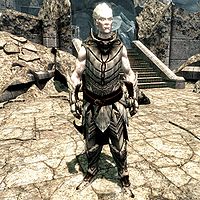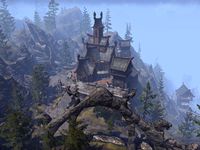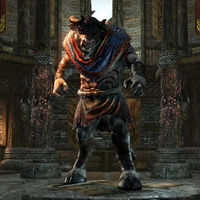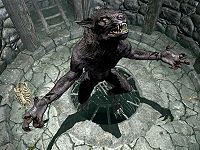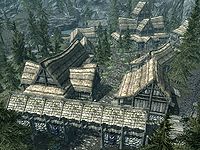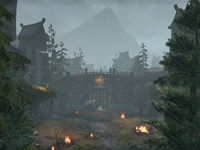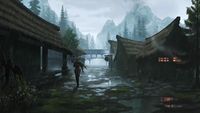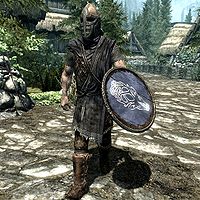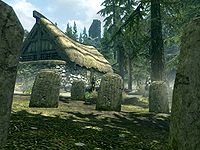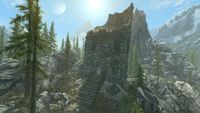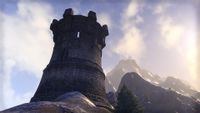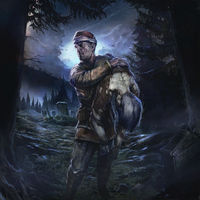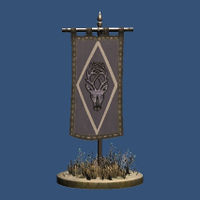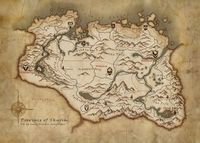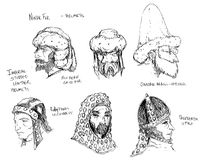Lore:Falkreath
| Falkreath | |
|---|---|
| Type | Settlement |
| Continent | Tamriel |
| Province | Skyrim |
| Hold | Falkreath |
| Appears in | Arena, Skyrim, Legends, ESO |
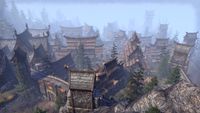
|
Falkreath (also called Falcrenth[2] or Falcreath)[3] is one of the nine major cities in the province of Skyrim,[4][5] serving as the capital of Falkreath Hold and the boreal forest. Its name derives from Elvish, though its meaning is unknown.[1]:573 The city is known as the "heroes' graveyard"; many great battles took place here for centuries, and countless warriors were buried here, leaving behind graves and monuments to them.[6] Because of the nature of the city, the merchants of Falkreath are known to reflect the melancholic themes of death in their business.[7]
Layout and Geography[edit]
Falkreath lies in the southern forests of Skyrim, on a strategic crossroad in the middle of its respective hold and the provincial border towards Hammerfell's wilder country, the Dragon's Teeth Mountains.[3] It is built in the forest basin between the Jerall Mountains and the highlands that contain the Shriekwind Bastion, where a small lake forms at the base, suited for a mill in this lumber-town. It is a city that is heavily reliant to the lumber industry, due to the abundance of resources around them.[7] In the Second Era, Falkreath was much larger in scope. The jarl's longhouse once overlooked the town from the hills in the south, while the original Hall of the Dead was kept underneath the mountains. Nowadays, the current hall was a single home for the priest, as they tended to the expansive graveyard in the city's northern section. The jarl's longhouse is stationed in the dead center of the city, on the main road that runs through Falkreath. The land outside of the city is largely unpopulated, but beyond the western gate, the Dark Brotherhood sanctuary was found just off the road. The Nords of Falkreath are known to master the ability to tame Sabre Cats, who are considered much more feral and wild than the Senche-Cat.[8] Falkreath is neighbored by several settlements, including Neugrad Watch to the northeast, North Keep to the far north, and Hammerfell to the west towards Elinhir.[5][9]
Notable Locales[edit]
|
|
|
History[edit]
Proto-History and the Men-of-'Kreath[edit]
The city loans its name from the Elvish language, but whatever connection the Snow Elves had to the area in ancient times is unknown.[1]:573 The earliest allusions to Falkreath come from two poetic works of the First Era: The Adabal-a, attributed to Morihaus, and The Song of Pelinal, written by various unknown authors. The former work mentions a tribe called the "men-of-'kreath", who were "imported from the North" as slaves to the Ayleids. According to the latter work, Pelinal Whitestrake achieved the liberation and empowerment of the men-of-'kreath after orchestrating a massacre of elves in the "northern holdings" (presumably southern Skyrim and northern Cyrodiil). As they are not described as being Nords, the men-of-'kreath seem to have been a distinct group of humans that were indigenous to the region.
Foundation and Early Nordic History[edit]
Falkreath was founded by ancient Nord warrior Bjarfrud Skjoralmor, who drove out "beastly" woodland inhabitants and cut down the great forest to build the settlement.[10] Many battles occurred near Falkreath for countless centuries, and many graves and monuments were built to commemorate the fallen. The town essentially grew around its cemeteries.[6]
According to the Poetic Edda, Falkreath was one of the places that submitted to Olaf One-Eye as High King of Skyrim.[11] A statue once stood commemorating the spot where Kjoric the White fell in battle defending Falkreath from the First Empire; local legend has it that his son, Hoag Merkiller, fell in exactly the same spot when he retook Falkreath years later,[12]:901 however, he was known to have actually fallen in the Battle of Glenumbra Moors.
Later in the First Era, the Nedic king Kestic may have held sway over the Falkreath area, as evidenced by his epithet, "the Forest King". He was the last to hold this title, as the Nedic civilization of the Deathlands fell with the arrival of the Ra Gada in 1E 808.[13][14]
Falkreath's history is intertwined with that of Colovia, as control of Falkreath often shifted between the Colovian estates and the holds of Skyrim. The earliest account of this was during an interregnum between the First and Second Empires when the Colovian nations had split apart from each other and their leaders became thief-barons and petty-kings. That was until the arrival of Reman I and the formation of his Empire, although Falkreath's role during this time is unknown.[15]
Falkreath in the Second Era[edit]
With the death of High King Logrolf in 2E 431, Skyrim split into eastern and western parts. The Western Kingdom, which included Falkreath, followed High King Svartr, who ruled from Solitude.[16][17] The Skjoralmor Clan (descended from Bjarfrud Skjoralmor) ruled as jarls of Falkreath during the Interregnum, and were aligned with the Western Kingdom.
When the Imperial Province of Orsinium was sacked in 2E 431, it displaced many Orsimer, who in turn fled to Skyrim and formed a large chiefdom under Yashnag gro-Yazgu. The chiefdom was considered the height of Orcish power in Skyrim and it was stationed in western Falkreath Hold, often harassing the hold capital. High King Svartr was unable to stop the threat it imposed, which ultimately led to the death of the Jarl of Falkreath. His son Hakkvild took his place and challenged Yashnag in a ritual of combat. In the end, Hakkvild had slain the Orcish chief and garnered the title "Yashnag-Slayer". His victory led to the dissolution of the chiefdom and their return to the Wrothgarian Mountains in 2E 467.[18]
During Kurog gro-Bagrakh's consolidation of power, he planned to reestablish the Orcish kingdom in Falkreath and create an Orcish city to rival Wayrest. During this period, Kurog's forces were accumulating in the Druadach Mountains, ready to take Falkreath, however, the Nords held them back. Kurog gave this plan up after becoming allies with King Emeric.[19]
Icereach Witches and Imperial Intervention[edit]
Circa 2E 577, after Varen's Rebellion, Reachfolk were driven out of Cyrodiil by Imperial forces. The Icereach Coven, as former advisors and teachers of the overthrown Emperor Leovic, were among them.[20] They were led by a powerful witch known as Mother Ciannait and during their escape from the Cyrodiil they wound up in the area west of Falkreath. They had taken refuge among the graves west of the town and raised numerous dead Nords from the graveyard to defend themselves from Imperial forces. Ultimately Imperials ceased to continue their pursuit once they suffered great losses and left the matters surrounding the Reachfolk incursion to the local Nords.[21] The Nords eventualy managed to cast the faction of Reach Witches out back to their ancient base in the island of Icereach.[22]
Dreadhorn Clan's Siege[edit]
Under the command of Domihaus the Bloody-Horned, the Dreadhorn Clan planned to wrest control of their ancestral lands in Falkreath Hold from the Nords,[23] greatly emboldened by their armaments from the Bloodroot Forge.
In the years prior to the Alliance War in 2E 582, Falkreath was ruled by Jarl Hjurgol Skjoralmor, who did not act justly in the days leading to the sacking of Falkreath.[24] The Jarl took to hiding in his longhouse, while his daughter and thane, Eerika Skjoralmor, led the remnants of the resistance.[25] She held the town for some time until the intervention of the Undaunted, who delved through the battlefield and aided the Thane in their efforts to save the city. The group was able to defeat Domihaus at the Jarl's Keep and witness the coronation of Jarl Eerika.[26]
Falkreath in the Age of the Septims[edit]
In the latter years of the Interregnum, Falkreath was once again part of the Colovian Estates, who were also split into petty-kings and warlords, while the divided kingdoms of Skyrim had dissolved. King Cuhlecain of Falkreath sought to unify the estates but in order to move forward, he needed to secure his northern border, towards the Reach. His prized general, Hjalti Early-Beard, led his forces at the Battle of Old Hroldan, but as the siege proved that breaking the walls was impossible, the next morning he used his Thu'um to obliterate it and win the battle. With this newfound power, King Cuhlecain unified the west and conquered the east, preparing to proclaim himself Emperor. But he was later assassinated and Hjalti, now known as Tiber Septim, was named the Emperor. What followed was the Tiber War.[27]
During the Imperial Simulacrum in the late Third Era, the city-state of Falkreath was an active settlement. It was ruled by King Bjeld, and it had a rivalry with Whiterun.[2] When the Oblivion Crisis broke out in 3E 433, Skyrim was under siege and faced severe casualties, where it was said everything between Falkreath and Windhelm was laid waste by the daedric hordes.[28]
Fourth Era[edit]
Dengeir of Stuhn served as the Jarl of Falkreath in the years that preceded the Skyrim Civil War. He was encouraged by many people to step down as the Jarl when he supported the rebellious Stormcloaks, as opposed to the Third Empire.[29] The position of leader of Falkreath was then given to his nephew, Siddgeir, who was known to be arrogant yet loyal to the Empire, although it was his steward Nenya that fulfilled the role as leader much more than him.[6] Legate Skulnar commanded the Imperial Legion throughout Falkreath Hold, and the stronghold of Fort Neugrad was a vital position for Falkreath's allegiance in the civil war.
Known Rulers[edit]
- See this section in the following article: Falkreath Hold
Gallery[edit]
-
Falkreath Defiler (Legends)
Notes[edit]
- The Nords of Falkreath practice an old Nordic custom with their dead called grave curd, in which a fresh piece of cheese is placed on top of a loved one's coffin, and every year on the anniversary, a fifth of the cheese is consumed by the family.[30]
- Arena was originally conceived as a fighting game featuring a tournament that took the player to each of Tamriel's cities to challenge different gladiatorial teams. According to a file from that stage of development left behind in the final game, Falkreath's gladiatorial team would have been called "the Dark Shadows".[UOL 1]
See Also[edit]
- For game-specific information, see the Arena, Skyrim, Elder Scrolls Online
 , and Legends articles.
, and Legends articles.
Books[edit]
- Beware of Falkreath by Jofnhild — A letter from a concerned Nord father
- Epitaph of Bjarfrud Skjoralmor — An epitaph to the founder of Falkreath
References[edit]
- ^ a b c d The Elder Scrolls V: Skyrim: Prima Official Game Guide — David Hodgson
- ^ a b Falcrenth location and rumors in Arena
- ^ a b King Edward, Part VII — Anonymous
- ^ Map of Skyrim – The Elder Scrolls V: Skyrim
- ^ a b Map of Skyrim – The Elder Scrolls: Arena
- ^ a b c Nenya's dialogue in Skyrim
- ^ a b Falkreath loading screen in Skyrim
- ^ Elder Scrolls Online - Crown Store Showcases (Mounts)
- ^ Map of Hammerfell – The Elder Scrolls: Arena
- ^ Epitaph of Bjarfrud Skjoralmor
- ^ King Olaf's Verse
- ^ The Elder Scrolls V: Skyrim Legendary Prima Official Game Guide
- ^ Nedes of the Deathlands — Argus Mender
- ^ Saradin's Diary — Saradin
- ^ Remanada
- ^ The Crown of Freydis — Taleon Mythmaker
- ^ Loremaster's Episode of ESO-RP ZOS Interview
- ^ Orcs of Skyrim — Thora Far-Wanderer
- ^ The Chronicles of King Kurog, Book IV — Zephrine Frey, Chronicler of Wayrest
- ^ Secret History of the Longhouse Emperors — Councilor Vandacia
- ^ Meet the Character - Mother Ciannait — Optio Cornelia Midara
- ^ Arvnir's dialogue in ESO
- ^ Meet the Character - Domihaus the Bloody-Horned — Gherig Bullblood
- ^ In Reply to Concerning Rumors — Jarl Hjurgol Skjoralmor
- ^ Beware of Falkreath — Jofnhild
- ^ Falkreath's Demise quest in ESO: Horns of the Reach
- ^ The Arcturian Heresy — The Underking, Ysmir Kingmaker
- ^ Tamriel Gate Response rumors in Oblivion
- ^ Dengeir of Stuhn's dialogue in Skyrim
- ^ Cheeses of Skyrim: Riften, Falkreath — B.
Note: The following references are considered to be unofficial sources. They are included to round off this article and may not be authoritative or conclusive.
